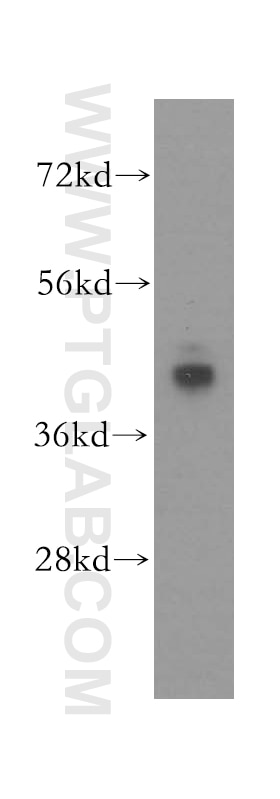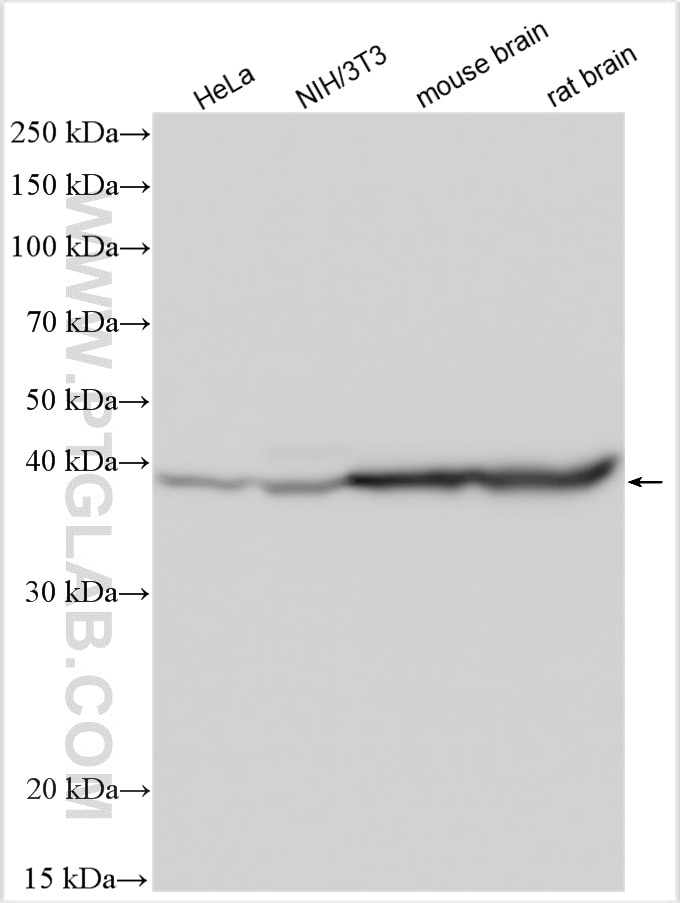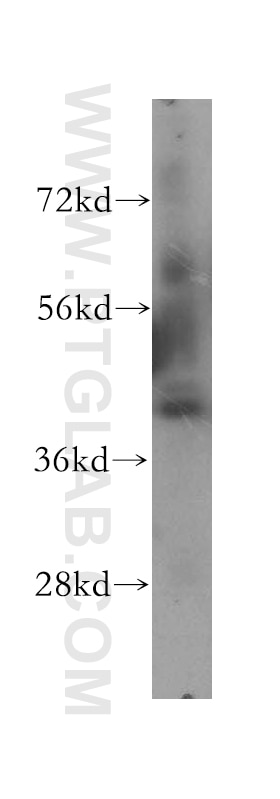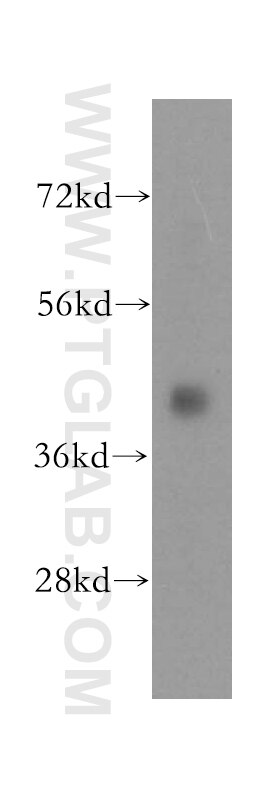Anticorps Polyclonal de lapin anti-ATP6V1C1
ATP6V1C1 Polyclonal Antibody for WB, IHC, ELISA
Hôte / Isotype
Lapin / IgG
Réactivité testée
Humain, rat, souris
Applications
WB, IHC, ELISA
Conjugaison
Non conjugué
N° de cat : 16054-1-AP
Synonymes
Galerie de données de validation
Applications testées
| Résultats positifs en WB | cellules HeLa, cellules NIH/3T3, tissu cérébral de rat, tissu cérébral de souris, tissu cérébral humain, tissu testiculaire humain |
| Résultats positifs en IHC | tissu de cancer de l'estomac humain il est suggéré de démasquer l'antigène avec un tampon de TE buffer pH 9.0; (*) À défaut, 'le démasquage de l'antigène peut être 'effectué avec un tampon citrate pH 6,0. |
Dilution recommandée
| Application | Dilution |
|---|---|
| Western Blot (WB) | WB : 1:1000-1:4000 |
| Immunohistochimie (IHC) | IHC : 1:20-1:200 |
| It is recommended that this reagent should be titrated in each testing system to obtain optimal results. | |
| Sample-dependent, check data in validation data gallery | |
Applications publiées
| WB | See 8 publications below |
| IHC | See 1 publications below |
Informations sur le produit
16054-1-AP cible ATP6V1C1 dans les applications de WB, IHC, ELISA et montre une réactivité avec des échantillons Humain, rat, souris
| Réactivité | Humain, rat, souris |
| Réactivité citée | Humain, souris |
| Hôte / Isotype | Lapin / IgG |
| Clonalité | Polyclonal |
| Type | Anticorps |
| Immunogène | ATP6V1C1 Protéine recombinante Ag9020 |
| Nom complet | ATPase, H+ transporting, lysosomal 42kDa, V1 subunit C1 |
| Masse moléculaire calculée | 382 aa, 44 kDa |
| Poids moléculaire observé | 42-44 kDa |
| Numéro d’acquisition GenBank | BC010960 |
| Symbole du gène | ATP6V1C1 |
| Identification du gène (NCBI) | 528 |
| Conjugaison | Non conjugué |
| Forme | Liquide |
| Méthode de purification | Purification par affinité contre l'antigène |
| Tampon de stockage | PBS with 0.02% sodium azide and 50% glycerol |
| Conditions de stockage | Stocker à -20°C. Stable pendant un an après l'expédition. L'aliquotage n'est pas nécessaire pour le stockage à -20oC Les 20ul contiennent 0,1% de BSA. |
Informations générales
The vacuolar H+-ATPase (V-ATPase) is a functionally conserved multimeric complex localized at the membranes of many organelles where its proton-pumping action is required for proper lumen acidification (PMID: 39210597). ATP6V1C1, also known as ATPase, H+ transporting, lysosomal V1 subunit C1, is a component of the V1 sector of the V-ATPase complex. ATP6v1c1 knockdown significantly reduces tumor stimulated bone resorption through osteoclastogenesis at the bone and metastasis in vivo, as well as V-ATPase activity, proliferation, and mTORC1 activation in vitro (PMID: 28504970). Also, ATP6V1C1, associated with the tumor microenvironment and mTORC1 signaling pathway, is a potential diagnostic, prognostic, and therapeutic biomarker for hepatocellular carcinoma () (PMID: 39557733).
Protocole
| Product Specific Protocols | |
|---|---|
| WB protocol for ATP6V1C1 antibody 16054-1-AP | Download protocol |
| IHC protocol for ATP6V1C1 antibody 16054-1-AP | Download protocol |
| Standard Protocols | |
|---|---|
| Click here to view our Standard Protocols |
Publications
| Species | Application | Title |
|---|---|---|
J Biol Chem A brain-enriched Drp1 isoform associates with lysosomes, late endosomes and the plasma membrane. | ||
Commun Biol A substrate-trapping strategy to find E3 ubiquitin ligase substrates identifies Parkin and TRIM28 targets. | ||
Biochem Biophys Res Commun Lysosome-associated membrane protein-2 deficiency increases the risk of reactive oxygen species-induced ferroptosis in retinal pigment epithelial cells. | ||
Bioengineered A novel four-gene of iron metabolism-related and methylated for prognosis prediction of hepatocellular carcinoma. | ||
Autophagy Inhibition of autophagy and induction of glioblastoma cell death by NEO214, a perillyl alcohol-rolipram conjugate |







